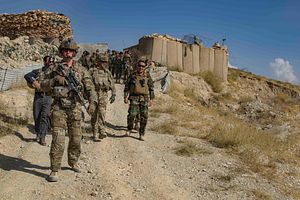U.S. efforts to restart peace talks with the Taliban in Afghanistan appear to be rooted for now in a possible prisoner exchange and separate initiatives — notably featuring China, Russia, and others — are underway. If any of these efforts are to be successful in the long-term, however, attention will need to turn to what happens after the “peace” is agreed.
The 45th quarterly report by the Special Inspector General for Afghanistan Reconstruction (SIGAR), released last week, highlighted the independent body’s seventh “lessons learned” report. Released in September, the lessons learned report examined five key post-2001 efforts at reintegrating fighters, the effect of local arrangements, and case studies focused on reintegration efforts in Colombia and Somalia.
Between 2003 and 2016, there were four main Afghan reintegration programs: the Disarmament, Demobilization, and Reintegration program (DDR, 2003–2005); the Disbandment of Illegal Armed Groups program (DIAG, 2005–2011); Program Tahkim-e Sulh (PTS or Strengthening Peace Program, 2005–2011); and the Afghanistan Peace and Reintegration Program (APRP, 2010–2016). A fifth program is ongoing, focused on reintegration commitments made when Hezb-i-Islami — headed by Gulbuddin Hekmatyar — settled a peace with the Afghan government in September 2016.
The report’s findings do not inspire a great degree of hope. Many features evident in the failures of past reintegration efforts remain relevant to the contemporary reality in Afghanistan today, from the lack of a comprehensive peace agreement to short-sighted policy decisions and a lack of economic opportunity.
Prior Afghan reintegration programs failed, the SIGAR report notes, because they took place absent a “comprehensive political settlement or peace agreement.”
But in the more recent, and ongoing, case of reintegration efforts regarding Hezb-i-Islami Gulbuddin (HIG) fighters even when there is an agreement in place, SIGAR says that the integration of HIG fighters into government security forces has stalled. There are multiple causes of the stall, including “changes in the recruitment and retirement of security forces and opposition from other factions.” Furthermore, as a peace deal with the Taliban loomed, SIGAR commented, “the integration of HIG fighters is likely to take a back seat for the time being.”
Arguably, even as the U.S. and others seek to find a peace deal with the Taliban, there are other factors outside the lack of such an agreement that bode ill for reintegration efforts once an agreement is reached.
For example, another major finding from the SIGAR report is that insecurity and threats facing participants in reintegration programs, a weak economy and limited government capacity factored into the failure of previous programs.
As SIGAR’s latest quarterly report underscores, violence in Afghanistan has escalated even as the peace process continued. Civilian casualties spiked as did combat casualties. The recent presidential election experienced far less violence than expected, in part because of Afghan security forces’ efforts; but Taliban subversion and threats also depressed voter turnout and reportedly more than 1,000 polling places were closed due to security concerns.
On the economic front, the Afghan economy remains fragile and aid-dependent. According to Afghan government-provided data analyzed by SIGAR, the government’s revenue growth in the latest fiscal year slowed to 3.2 percent, year-on-year — revenues had grown by 14 percent in the 2017-2018 period. According to the World Bank, donor grant finance about 75 percent of all public expenditures in Afghanistan. This is not a healthy economy into which former fighters can easily fit and find work as lucrative as their previous trade in violence.
As another of the report’s findings notes, “None of the four main reintegration programs entailed a long-term effort to assist former combatants to transition to a sustainable alternative livelihood.” Short-term and short-sighted efforts do not a sustainable reintegration make.
The report offers 10 lessons worth paying attention to and attendant recommendations.
Perhaps most important is a plea for Congress to avoid funding a reintegration program absent a deal on the terms between the Afghan government and the Taliban. U.S. efforts to reach a deal with the Taliban have largely excluded the Afghan government, an effort to sell a reintegration program Kabul isn’t even consulted on would be a foolish purchase. But while the time may not be right for such a program today, when such a program is needed and best able to succeed, it will need to be comprehensive and carefully considered. Thinking ahead wouldn’t hurt.

































